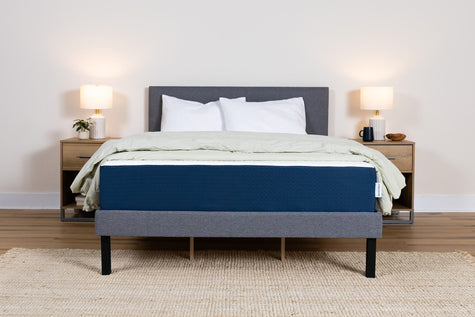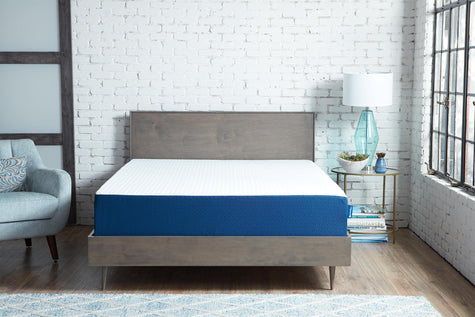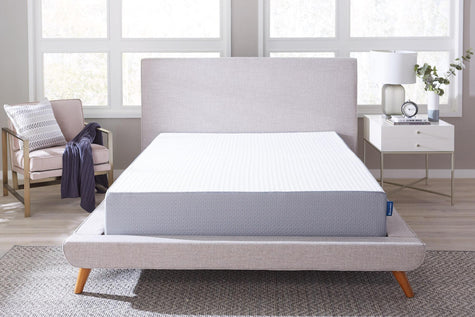What Is Mattress Temperature?
Mattress temperature refers to how hot or cool your mattress is, which largely depends upon the mattress material. Sleeping in an environment that is too hot or cold can lead to sleep issues such as insomnia and fatigue. While it is important to maintain a comfortable sleep environment, extreme temperatures, age, gender, and personal preferences can all affect how hot or cool you prefer your sleep space.
While everyone has different preferences, this mattress temperature guide offers a general overview of which mattresses are the best for staying cool, how you can achieve an optimal sleep temperature, and how maintaining a comfortable temperature can lead to a better quality of sleep.
How Temperature Affects Your Sleep Quality
The temperature of your sleep environment has significant effects on how well you sleep and your circadian rhythm, or your internal clock that controls your sleep/wake cycle. The more extreme the temperature of your room is, the more likely you will wake up in the middle of the night because your body cannot fall into a naturally deep sleep. Other issues that can arise from extreme temperatures include chronic insomnia and fatigue.
Our bodies naturally maintain a temperature of around 98.5 degrees Fahrenheit (37 degrees Celsius) that fluctuates throughout the day and night. As bedtime approaches, our core body temperature decreases by about 2 degrees Fahrenheit, then rises gradually as we begin to wake up in the morning.
This process of internal temperature maintenance is called thermoregulation, which is strongly linked to sleep. Having a room or mattress that is too hot or too cold can be detrimental to sleep because of the effects on thermoregulation. These effects can be worsened for those who have health conditions that already make it difficult to sleep, such as sleep apnea or insomnia.
Extremely Hot Temperatures
Extremely hot and humid environments affect our core body temperature by making it more difficult to fall into REM (rapid eye movement) sleep. As a result, if you sleep hot or live in a hot environment, you may find yourself waking up often and unable to fall into a deep, restful sleep. This can further lead to feeling tired or stressed in the morning.
To combat hot temperatures, try to keep the blinds closed during the day, use a fan or air conditioner to promote cool air circulation, and sleep on breathable materials.
Extremely Cold Temperatures
Extremely cold temperatures can be a nightmare for those who don’t sleep hot and can lead to long hours awake or trying to layer up to get more comfortable. Even sleeping under an air conditioner during the hot months can cause issues such as tossing and turning throughout the night or elevated heart rate and blood pressure.
If you find yourself unable to fall asleep or are consistently waking up due to cold temperatures, you may want to consider layering up your bed covers and blankets. Layering your bed covers and wearing warmer sleepwear - long sleeves, pants, and socks - are sure to help you feel warmer and get the rest you need, even on cool mattresses.
Ideal Sleeping Temperatures
Knowing the perfect temperature to sleep at can make a big difference in both the quality and duration of your sleep. This section will discuss how different surroundings and personal preferences affect the ideal temperature ranges for a restful night's sleep.
68 & below
The body tends to cool down more quickly at temperatures 68°F and lower, which encourages the natural drop in core temperature required for falling asleep. These temperatures, however, might be too chilly for certain people, which could cause sleep disturbances because the body would have to work harder to stay warm.
68-72
For most people, temperatures from 68°F to 72°F are ideal because they provide a balance that supports the body's natural thermal regulation processes. The body may effectively drop its core temperature in this range without being overly frigid, allowing for peaceful slumber. With fewer disruptions, deeper, more restorative sleep cycles are possible within this range.
72-75
For some sleepers, temperatures between 72°F and 75°F may seem warm, which could interfere with the body's capacity to cool down and allow for the best possible relaxation. This range, while still pleasant for many people, may cause minor disturbances in sleep quality, especially for people who are hot-sensitive or prone to night sweats.
75+
The body's natural capacity to cool down for sleep might be hindered by an uncomfortable sleeping environment when the temperature rises above 75°F. This may result in fewer deep sleep stages, frequent awakenings, and restless nights. Extended periods of exposure to warm weather can lead to weariness, a decrease in sleep quality overall, and persistent sleep disruptions.
Accessories to Help You Gain Temperature Control
Many times, a few essential things are needed to get the perfect sleeping temperature. Using fans, which encourage airflow and aid in removing heat, is a basic method. You may establish the perfect temperature for sleeping with the help of air conditioners, which are quite effective at controlling temperature precisely. Furthermore, maintaining open windows can improve natural ventilation by drawing in cooler night air. Breathable bedding, moisture-wicking sheets, and cooling mattress toppers are further techniques for controlling body temperature. By combining these products, you can make your bedroom comfortable, stay cool all night, and get uninterrupted, rejuvenating sleep.
Mattress Size and Sleep Temperatures
- Bigger Mattresses: King and queen sizes provide greater space for the dispersion of heat, which facilitates cooling.
- Smaller Mattresses: Due to their smaller dimensions, twin or full sizes may retain more heat, which could raise body temperature.
- Partner Considerations: Sharing a bed can elevate temperatures; consider cooling accessories to balance body heat.
- Material Impact: Gel-infused foam mattresses and other larger mattresses that contain cooling elements can improve temperature management.
- Mobility and Space: More room on larger mattresses helps to provide a cooler sleeping environment by preventing the accumulation of body heat.
What Are the Coolest Mattress Materials?
Among the four main mattress constructions—memory foam, latex, innerspring, and hybrid—some are better at keeping you cool than others. While you may also want to consider factors like mattress firmness, thickness, and price when shopping around, it is crucial to take mattress temperature into consideration.
Memory Foam
Memory foam mattresses can be among the coolest mattresses, but generally only if they include cooling technologies. For instance, our BedInABox® memory foam and hybrid mattresses include a layer of CoolRest® Gel Memory Foam that both supports your body and helps maintain your body temperature throughout the night. In addition, select mattresses, including the Azul® and Dual Hybrid®, are topped with a soft-knit cover made with UltraCool® technology. This technology makes the mattress cover feel cool to the touch by infusing a phase change material into the cover material. Finally, our Eco-Lux® features a breathable, moisture-wicking organic cotton cover that helps you stay cool by minimizing heat retention.
Latex
Latex mattresses tend to maintain a neutral temperature no matter what the room temperature is. As such, they can be a great option for people who sleep hot, especially since latex does not conduct heat well.
Innerspring
While not as dense or pressure relieving as memory foam mattresses, the construction of a traditional innerspring mattress usually promotes airflow thanks to the springs or coils.
Hybrid
Hybrid mattresses are made of a mixture of foam and springs. The coils are generally used in the bottom half of the mattress, while memory foam is layered on top. If a cooling gel foam is used, such as the CoolRest® Gel Memory Foam used in BedInABox® mattresses, a hybrid mattress can be extremely effective at deflecting heat.
Sleep Cool with BedInABox®
Looking for a mattress that keeps you cool and comfortable? Look no further. BedInABox® mattresses feature layers of CoolRest® Gel Memory Foam and are topped with soft knit covers infused with materials or cooling technologies to keep you sleeping cooler, longer. With mattresses designed to maximize support and temperature regulation, you can get the sleep you need without sacrificing comfort. If you have questions about any of our mattresses, contact us today to find out which BedInABox® mattress is best for you.



